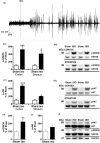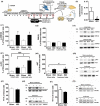Brief isoflurane anesthesia regulates striatal AKT-GSK3β signaling and ameliorates motor deficits in a rat model of early-stage Parkinson's disease
- PMID: 28488766
- PMCID: PMC5575520
- DOI: 10.1111/jnc.14066
Brief isoflurane anesthesia regulates striatal AKT-GSK3β signaling and ameliorates motor deficits in a rat model of early-stage Parkinson's disease
Abstract
Parkinson's disease (PD) is a progressive neurodegenerative movement disorder primarily affecting the nigrostriatal dopaminergic system. The link between heightened activity of glycogen synthase kinase 3β (GSK3β) and neurodegene-rative processes has encouraged investigation into the potential disease-modifying effects of novel GSK3β inhibitors in experimental models of PD. Therefore, the intriguing ability of several anesthetics to readily inhibit GSK3β within the cortex and hippocampus led us to investigate the effects of brief isoflurane anesthesia on striatal GSK3β signaling in naïve rats and in a rat model of early-stage PD. Deep but brief (20-min) isoflurane anesthesia exposure increased the phosphorylation of GSK3β at the inhibitory Ser9 residue, and induced phosphorylation of AKTThr308 (protein kinase B; negative regulator of GSK3β) in the striatum of naïve rats and rats with unilateral striatal 6-hydroxydopamine (6-OHDA) lesion. The 6-OHDA protocol produced gradual functional deficiency within the nigrostriatal pathway, reflected as a preference for using the limb ipsilateral to the lesioned striatum at 2 weeks post 6-OHDA. Interestingly, such motor impairment was not observed in animals exposed to four consecutive isoflurane treatments (20-min anesthesia every 48 h; treatments started 7 days after 6-OHDA delivery). However, isoflurane had no effect on striatal or nigral tyrosine hydroxylase (a marker of dopaminergic neurons) protein levels. This brief report provides promising results regarding the therapeutic potential and neurobiological mechanisms of anesthetics in experimental models of PD and guides development of novel disease-modifying therapies.
Keywords: anesthesia; dopamine; neurodegeneration; phosphorylation; sensorimotor test.
© 2017 The Authors. Journal of Neurochemistry published by John Wiley & Sons Ltd on behalf of International Society for Neurochemistry.
Figures


Similar articles
-
The anti-aging protein klotho alleviates injury of nigrostriatal dopaminergic pathway in 6-hydroxydopamine rat model of Parkinson's disease: Involvement of PKA/CaMKII/CREB signaling.Exp Gerontol. 2017 Dec 15;100:70-76. doi: 10.1016/j.exger.2017.10.023. Epub 2017 Nov 5. Exp Gerontol. 2017. PMID: 29107062
-
Human Basic Fibroblast Growth Factor Inhibits Tau Phosphorylation via the PI3K/Akt-GSK3β Signaling Pathway in a 6-Hydroxydopamine-Induced Model of Parkinson's Disease.Neurodegener Dis. 2016;16(5-6):357-69. doi: 10.1159/000445871. Epub 2016 May 27. Neurodegener Dis. 2016. PMID: 27228974
-
Dopaminergic neuroprotection and regeneration by neurturin assessed by using behavioral, biochemical and histochemical measurements in a model of progressive Parkinson's disease.Brain Res. 2002 Aug 30;947(2):271-83. doi: 10.1016/s0006-8993(02)02934-7. Brain Res. 2002. PMID: 12176170
-
Mesial temporal dopamine: From biology to behaviour.Eur J Neurosci. 2024 Mar;59(6):1141-1152. doi: 10.1111/ejn.16209. Epub 2023 Dec 6. Eur J Neurosci. 2024. PMID: 38057945 Review.
-
Targeting of the PI3 K/AKT/GSK3β Pathway in Parkinson's Disease: A Therapeutic Blueprint.Mol Neurobiol. 2025 Jun 5. doi: 10.1007/s12035-025-05113-y. Online ahead of print. Mol Neurobiol. 2025. PMID: 40474025 Review.
Cited by
-
Ketamine-50 years in use: from anesthesia to rapid antidepressant effects and neurobiological mechanisms.Pharmacol Rep. 2021 Apr;73(2):323-345. doi: 10.1007/s43440-021-00232-4. Epub 2021 Feb 20. Pharmacol Rep. 2021. PMID: 33609274 Free PMC article. Review.
-
Dual effects of GABA A R agonist anesthetics in neurodevelopment and vulnerable brains: From neurotoxic to therapeutic effects.Neural Regen Res. 2026 Jan 1;21(1):81-95. doi: 10.4103/NRR.NRR-D-24-00828. Epub 2024 Dec 7. Neural Regen Res. 2026. PMID: 39665822 Free PMC article.
-
Investigation of the inhibitory behavior of XFE and mitoxantrone molecules in interaction with AKT1 protein: a molecular dynamics simulation study.J Mol Model. 2023 Apr 22;29(5):153. doi: 10.1007/s00894-023-05520-9. J Mol Model. 2023. PMID: 37086344
-
Polygonatum sibiricum Polysaccharides Protect against MPP-Induced Neurotoxicity via the Akt/mTOR and Nrf2 Pathways.Oxid Med Cell Longev. 2021 Jan 13;2021:8843899. doi: 10.1155/2021/8843899. eCollection 2021. Oxid Med Cell Longev. 2021. PMID: 33520086 Free PMC article.
-
Commonly used anesthetics modify alcohol and (-)-trans-delta9-tetrahydrocannabinol in vivo effects on rat cerebral arterioles.BMC Anesthesiol. 2023 Dec 12;23(1):411. doi: 10.1186/s12871-023-02320-9. BMC Anesthesiol. 2023. PMID: 38087263 Free PMC article.
References
-
- Adachi Y. U., Yamada S., Satomoto M., Higuchi H., Watanabe K. and Kazama T. (2005) Isoflurane anesthesia induces biphasic effect on dopamine release in the rat striatum. Brain Res. Bull. 67, 176–181. - PubMed
-
- Andersen K., Balldin J., Gottfries C. G., Granérus A. K., Modigh K., Svennerholm L. and Wallin A. (1987) A double‐blind evaluation of electroconvulsive therapy in Parkinson's disease with “on‐off” phenomena. Acta Neurol. Scand. 76, 191–199. - PubMed
-
- Bychkov E., Ahmed M. R., Dalby K. N. and Gurevich E. V. (2007) Dopamine depletion and subsequent treatment with l‐DOPA, but not the long‐lived dopamine agonist pergolide, enhances activity of the Akt pathway in the rat striatum. J. Neurochem. 102, 699–711. - PubMed
Publication types
MeSH terms
Substances
LinkOut - more resources
Full Text Sources
Other Literature Sources
Medical

